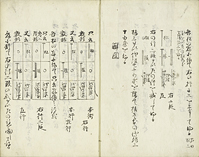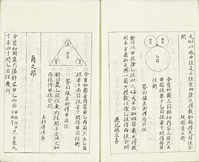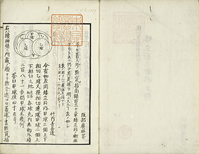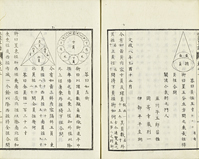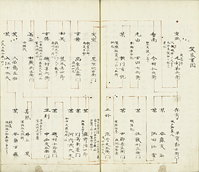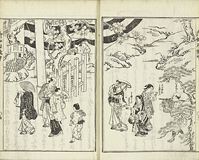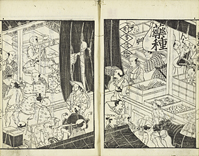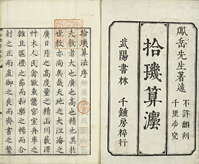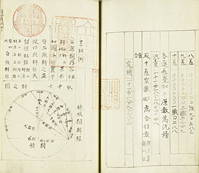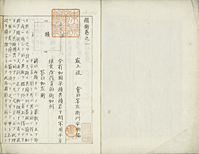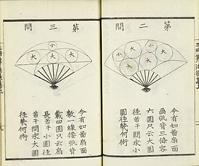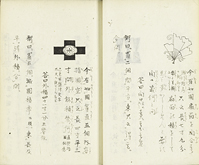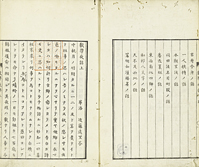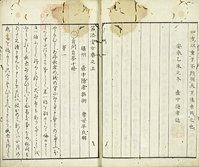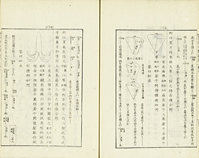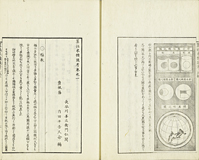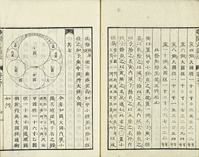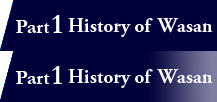3. Development of Wasan
This section introduces the various aspects that Wasan followed after Seki Takakazu (?-1708) based on two pillars: the master institution and the accomplishments of individual Wasan scholars.
Regarding the master institution, we exhibit introductory booklets for Wasan beginners, materials that show a competitive atmosphere in which Wasan scholars developed their mathematical attainment through friendly competition against each other, and a book that collected mathematical tablets used often by Wasan scholars as a means of announcing their results to the public. We also display a book that includes a diagram showing mentor-disciple relationships between Wasan scholars as a reference material.
This section of the exhibition also introduces materials related to some famous Wasan scholars in those days such as Nakane Genjun, Murai Chuzen, Arima Yoriyuki, and Aida Yasuaki.
In addition, we also exhibit materials to make audience aware of the aspect of Wasan as a hobby, which became conspicuous in the second half of the Edo period; essays about mathematics, and a book written by an author pretending to be a girl, and finally books that directly indicate examples of mathematical consummations attained by Wasan in the second half of the Edo period.
Master Institution
1 Hotei ryoshiki
Ms. 2 v. <140-212>
In Wasan in the Seki school after the eighteenth century, the items to be taught were organized and systematized, and elementary textbooks (manuscripts), etc., were developed. One such book is this Hotei ryoshiki.
The term "Hotei" appears in the Jiuzhang suanshu in ancient China, going back to the history of mathematics, and refers to linear simultaneous equations in current terms. In Wasan, Jinkoki also includes this type of problems. A problem often adopted as an exercise is as follows: assuming that three different goods A, B, and C are given, when one buys three sets of them, and each set consists of different numbers of As, Bs, and Cs, one must find the unit price of A, B, and C when the total amount for each set is given. This material takes up these types of exercises and carefully explains the solutions to them.
2 Sanpo hyoron
Ed. by Takayama Tadanao. Ms. 1 v. <112-82>
This book describes problems delivered in a private school hosted by Kubodera, a Wasan scholar, and answers to the problems and comments to the answers. Takayama Tadanano (1762-1835) and Takei Sadatomi, who wrote the preface, added comments to each of the posted problems. They classified the problems into five levels of Miya, Sho, Kaku, Bi, and Hane from best to worst, and added appropriate comments to them. Severe comments such as "the solution is roundabout" or "it does not make sense" are added to some problems. The content hints how Wasan scholars in the early nineteenth century studied mathematics through friendly competition.
3 Sureki soki
Ms. 1 v. <146-90>
Miscellanea complied by a Wasan scholar (editor unknown) in the last days of the Tokugawa regime.
This work includes, in random order, drafts and articles by Wasan scholars such as Kawada Yasunori (1796-1882), Sakabe Kohan(1759-1824), and Kenmochi Akiyuki (1790-1871). Particularly, it records many remarks to questions and answers exchanged between Wasan scholars. It arouses our interest because it allows us to catch a glimpse of the competitive consciousness and critical spirit regarding arithmetic problems among Wasan scholars in those days.
4 Shamei sanpu
Ed. by Shiraishi Nagatada. Rev. by Ikeda Sadaichi. 1826?. 2 v. <W385-N13>
The author and editor Shiraishi Nagatada (1795-1862) was a Wasan scholar of the Seki school who lived in Edo. This book is one of the best works edited and written by him. It is a book that collected mathematical tablets dedicated by Wasan scholars to shrines and temples across Japan.
Mathematical tablets (Sangaku) refer to mathematical problems dedicated to temples and shrines in the form of Ema (votive wooden tablets with a ridge in the form of a roof on which a horse is painted) by Wasan scholars all together across the country after the eighteenth century. A group of several volunteers belonging to the same Wasan school often dedicated mathematical tablets to temples and shrines, enabling them to gain publicity for their mathematics from the unknown number of visitors to the temples and shrines. The Shamei sanpu includes problems written in mathematical tablets posted across the country by Wasan scholars and students of Shiraishi. The included problems were of various levels of difficulty, and some of the exceptionally difficult problems were adopted and introduced into Wasan books in later generations. This material informs us of the realities of activities for dedicating mathematical tablets to shrines and temples, which was unique to Wasan.
5 Sugaku sosetsu
By Togawa Masaatsu. Ms. 1 v. <210-305>
Miscellanea related to Wasan, astronomy, and Western studies, written in the last days of the Tokugawa regime. It starts with simple formulae for arithmetic and ends with a "Wasan scholar relationship diagram" depicting mentor-disciple relationships between Wasan scholars. Between them, it includes copies of letters by Uchida Itsumi (1805-1882), who actively studied and adopted Western mathematics in the last days of the Tokugawa regime, abridged translations of Dutch books describing the boiling points of liquids, forewords and afterwords from Uchida's works, etc. Particularly, the copies of Uchida's letters (years unknown; addressed to Togawa) show some of his opinions about Western mathematics, which could be also regarded as a valuable testimony in the history of Wasan. Since letters addressed to Togawa are included, it is believed that the exhibited book was compiled by Togawa himself or by a person(s) close to him.
Wasan Scholars
6 Kanja otogi zoshi
By Nakane Genjun. Heian: Ten'nojiya Ichirobe, 1743. 3 v. <201-164>
The author Nakane Genjun (1701-1761) was a Wasan and calendar scholar. He was the son of Nakane Genkei (1662-1733). This book is not a systematized Wasan book but one that is mainly compiled from mathematical recreations, featuring inserted illustrations throughout. It freely covers an assortment of both hard (academic) and soft (recreational) materials.
At the end, it introduces the results of the fields into which most research efforts were poured in those days, such as Kohaijutsu. It was Kasai who wrote the afterword to the book; he was a disciple of Nakane, and his principal occupation was the operator of a bookstore called Ten'nojiya. After this, Ten'nojiya would become the sole bookstore that undertook the publication of major mathematical books by the Seki school, including the works of Nakane and his father.
7 Sanpo dojimon
By Murai Chuzen. Heian: Ten'nojiya Ichirobe, 1784. 6 v. in 1. <202-229>
The author was a Wasan scholar living in Kyoto and a disciple of Nakane Genjun. He was under the wing of Arima Yoriyuki, the author of the next material. This book Sanpo dojimon has a form similar to that of Kanja otogi zoshi written by his master Nakane, including illustrations inserted throughout the book. However, Sanpo dojimon not only includes the details of arithmetic operations necessary for daily life, but also adds explanations about drawing figures using a compass, as well as about unique surveying. In addition, it includes at its end a general description of systems of weights and measures. It is an arithmetic book for the purpose of enlightenment and covers a wide variety of subjects from the West and from China.
8 Shuki sanpo
By Arima Yoriyuki. Koto: Suhara Mohei etc., 1769. 5 v. in 3. <112-80>
The author Arima Yoriyuki (1714-1783) was a feudal lord of the Kurume Domain. He is known for hiring Fujita Sadasuke (1734-1807), a Wasan scholar of the Seki school, and for engaging himself in Wasan research. This Shuki sanpo was published by the author's name of Toyota, but it was actually edited and compiled by Arima.
The content of the entire five volumes covers most of what the Seki school garnered in those days, and is a good material that provides us with a picture of the Seki school in the second half of the eighteenth century. The publication of these accomplishments by the Seki school prompted the spread of the leading-edge accomplishments of the Seki school in those days, and consequently caused many Wasan scholars to undertake writing many commentaries (manuscripts) to the Shuki sanpo.
9 Hoen kiko
By Arima Yoriyuki. Ms. 2 v. <139-109>
The author Arima Yoriyuki was the feudal lord of the Kurume Domain. (Refer to the previous material.)
This book was compiled from calculation methods related to circles and regular polygons. Some sections include chapters written by Yamaji Nushizumi (1704-1772) who taught Arima. It introduces not only various formulae, but also specific numerical solutions. The second volume includes content titled Katsujutsu, which generalizes the results obtained in the first volume. It is a book that indicates the consummation the Seki school reached in the middle of the eighteenth century.
The exhibited book was formerly owned by Ryuseikan, a clan school in Oshu Mizusawa.
10 Tetsujutsu
Ed. by Aida Yasuaki. Ms. 1 v. <112-72>
The author Aida Yasuaki (1747-1817) was a Wasan scholar from Yamagata. He came to Edo and tried to enroll in the Seki school hosted by Fujita Sadasuke; however, he was not accepted due to some trivial misunderstandings, and set up his own school, the Saijo school. Subsequently the two schools started to criticize each other through their works.
Tetsujutsu introduced here was compiled not from established general algorithms of the Seki school, but from unique computational techniques discovered by Aida.
Expansion of Wasan
11 Gomei sanpo 2
By Iesaki Yoshiyuki. Koto: Osakaya Mokichi, etc., 1826. 2 v. <184-70>
Gomei sanpo (1) by the same author is famous for its collection of geometric figure problems whose subjects are folding fans and round fans. The one introduced here is the sequel to the book. It does not limit materials to fans, and includes other problems such as Mushikuizan (a kind of crypt-arithmetic) and solid figures. Similar to the prequel, it is a book that is full of the passion and joy of setting problems. The first volume includes problems, while the second volume includes answers to them.
12 Sanpo monzukushi
By Taigajuku shujin. Ms. 1 v. <104-325>
The afterword says that this book was compiled in the third year of the Tenpo era (1832). We do not know who the author "Taigajuku shujin" was, or what his occupation was.
This book includes arithmetic problems involving family crests. It adopts various problems in a playful tone, such as problems formed from geometric elements in family crests and those based on materials from the animals and plants depicted in them. It is a book that directly embodies the recreational element of Wasan. This manuscript itself was manually copied by a person called Kuramochi Sadakuni in the second year of the Kaei (1849).
13 Sugaku yawa
By Nishimura Tosato. Keishi: Hayashi Ihee, etc., 1761. 1 v. <210-85>
The author Kondo Tosato (1716-1787) later referred to himself as Nishimura. He was a scholar specializing in calendars, who lived in Kyoto. This book is a collection of essays in a form of summarizing questions and answers related to mathematics exchanged between the author and his guests. Their discussions cover not only mathematical topics but also even general problems relating to physics and economics, such as the origins of arithmetic in Japan and in China, the systems of weights and measures from ancient times, general topics related to astronomy, and the qualities of magnets. It is a book that helps us to understand the opinions of a person involved in Wasan and calendar making during the Edo period on the activities in his own studies.
14 Sanpo shojo
Written by Chiba Tozo. Ed. by Taira Akiko. Toto: Yamazaki Kinbei, 1775. 1 v. <わ419-1>
First of all, this is a Wasan book whose fanciful title attracts our attention. Its foreword explains that the book was compiled by Taira Akiko herself from what "Kochu Inja" (meaning a hermit in a pot) (Chiba Tozo) taught his daughter (Akiko).
It is a collection of miscellaneous problems including questions the author asked and the answers he provided. Chiba's comments are added in places. It does not include particularly difficult problems; many of the problems are general and typical for that time.
The fact that this editor, Kochu Inja, assumed the surname of Chiba was revealed by a book later written by Aida Yasuaki, a Wasan scholar, in which he mentioned something to that effect. Chiba's dates of birth and death are unknown. His principal occupation was a medical doctor. The preface in Sanpo shojo hints that Chiba came to Edo from Settsu. We know little of his life.
Consummations in the Second Half of the Edo Period
15 Sanpo kyuseki tsuko
Rev. by Hasegawa Hiromu. Ed. by Uchida Kyumei. Edo: Okadaya Kashichi, etc., 1844. 5 v. <124-39>
16 Sanpo kyuseki tsuko
Rev. by Hasegawa Hiromu. Ed. by Uchida Kyumei. S.I.: Hankeisha, 1844. 5 v. <W385-30>
Among the Seki schools, it was the Hasegawa juku hosted by two generations (father and son, Hasegawa Hiroshi (1782-1838) and Hiromu (1810-1887)), that published many Wasan books and led the field in the last days of the Tokugawa regime. This juku, at which many disciples gathered from all over the country, undertook activities pursuing enlightenment and published books from elementary textbooks to professional Wasan books.
This Sanpo kyuseki tsuko is one of the most professional Wasan books of all. It selected mathematical problems with an emphasis on those that find the areas and volumes of plane figures surrounded by curved lines and solid figures surrounded by curved surfaces. In terms of modern mathematics, it tackles very complicated problems by combining series of formula groups of infinite series expansion. This book is the product of many years' labor, and shows the heights of consummation that Wasan reached.
Note that this book was displayed as one of the exhibits in the World Exposition held in Paris in 1867.
We post two variant editions of the book.
17 Kaishiki shinpo
By Kawai Hisanori. Rev. by Sakabe Kohan. Koto: Suharaya Mohei, etc., 1805. 2 v.<231-159>
The author Kawai Hisanori (1766-1835) was a Hatamoto of the Shogunate (samurai who guarded the camp of a shogun in feudal Japan) and a disciple of Sakabe Kohan as a Wasan scholar. (It was Sakabe who revised this book.)
This book describes extremely accurate knowledge of the number of solutions to equations called "Kaihoshiki" by Wasan scholars. It also introduces a technique by which the approximate solution of an equation can be found. Such topics are handled in the first volume, while the second volume solves specific exercises. This material demonstrates the level of algebraic knowledge held by Wasan scholars at the beginning of the nineteenth century.

